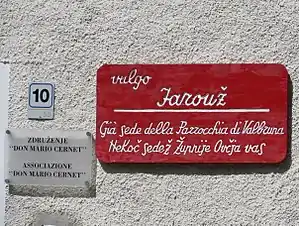
The traditional Slovene field and house names are part of the cultural heritage of Slovenians, as well as of German-speaking population of Carinthia, Austria. Many researchers, communities, and organizations work for preservation of the Slovenian microtoponyms.[1][2]
In 2010 the "Slovene field and house names in Carinthia" were included into the UNESCO Inventory of Intangible Cultural Heritage in Austria (de:Immaterielles Kulturerbe in Österreich). Preservation of Slovene placenames in this area is especially critical, because here for centuries the written language was German, while the tradition of Slovene was passed in spoken, dialectal form, and today only a small number of people use traditional names.[2]
There is a Slovenia-Austria cross-border cooperation aimed at the preservation of the field and house names. First local initiatives started in Gorenjska region of Slovenia in 2005. In 2008 they were joined by Southern Carinthia. The European cross-border project FLU_LED (2011-2015) joined the two efforts into one.[3] The two regions developed a common methodology for data collection and documentation (recording and mapping) and involved over 1,600 elderly people to collect the names. By 2020 15,700 house names and 9,600 field names were documented.[4][1]
See also
- de:Topographieverordnung für Kärnten (1977) (Topography Ordinance for Carinthia (1977))
References
- 1 2 Aseniya Dimitrova, "EU-funded initiative brings traditional Slovene house and field names back to life", themayor.eu, November 12, 2020
- 1 2 "Slovene field and house names in Carinthia [Kärnten]. Intangible cultural heritage of the Austrian Commission for UNESCO", United Nations Group of Experts on Geographical Names, Working Paper no. 11/16, 2016
- ↑ "Eno gibanje – tri delovna obdobja"
- ↑ "Name it in Slovenian!", a leaflet with basic information on the subject
External links
 Media related to Multilingual signs in Austria at Wikimedia Commons
Media related to Multilingual signs in Austria at Wikimedia Commons- "Kulturni portal ledinskih in hišnih imen / Kulturportal der Flur- und Hausnamen" (Cultural Portal of Field and House Names)